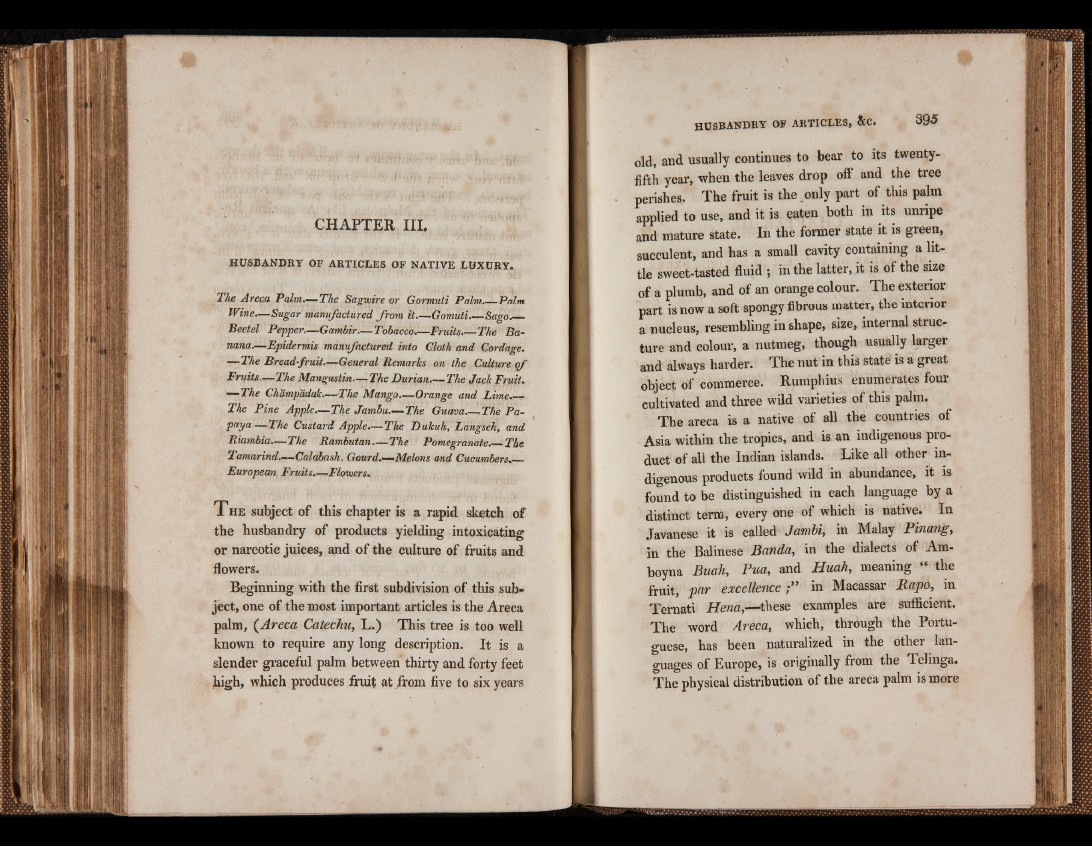
CHAPTER III.
HUSBANDRY OF ARTICLES OF NATIVE LUXURY.
The Areca Palm.— The Sagmre or Gormuti Palm.— Palm
Wine.— Sugar manufactured from it Gomuti Sago—
Beetel Pepper— Gambir— Tobacco Fruits.— The Banana—
Epidermis manufactured into Cloth and Cordage.
— The Bread-fruit— General Remarks on the Culture o f
Fruits— The Mangustin— The Durian.— The Jack Fruit.
— The Champadak— The Mangp.— Orange and Lime. -
The Pine Apple.— The Jambu.— The Guava.— The Papaya—
The Custard Apple.— The Dukuh, Langseh, and
Riambia.— The Rambutan.— The Pomegranate.— The
Tamarind— Calabash, Gourd."--Melons and Cucumbers.—
European Fruits.—-Flotvers.
T h e su b je c t o f th is ch ap te r is a rapid sk e tch o f
th e h u sb an d ry o f p rod u c ts y ie ld in g in to x ic a tin g
o r n a r co tic ju ic e s , an d o f th e cu ltu r e o f fruits a n d
flow e rs.
Beginning with the first subdivision of this sub*
ject, one of the most important articles is the Areca
palm, (Areca Catechu, L.) This tree is too well
known to require any long description. It is a
slender graceful palm between thirty and forty feet
high, which produces fruit at from five to six years
h u s b a n d r y of a r t ic l e s , &c. 3 9 5
old, and usually continues to bear to its twenty-
fifth year, when the leaves drop off and the tree
perishes. The fruit is the .only part of this palm
applied to use, and it is eaten both in its unripe
and mature state. In the former state it is green,
succulent, and has a small cavity containing a little
sweet-tasted fluid ; in the latter, it is of the size
of a plumb, and of an orange colour. The exterior
part is now a soft spongy fibrous matter, the interior
a nucleus, resembling in shape, size, internal structure
and colour, a nutmeg, though usually larger
and always harder. The nut in this state is a great
object of commerce. Rumphius enumerates four
cultivated and three wild varieties of this palm-
The areca is a native of all the countries of
Asia within the tropics, and is an indigenous product
of all the Indian islands. Like all other indigenous
products found wild in abundance, it is
found to be distinguished in each language by a
distinct term, every one of which is native. In
Javanese it is called Jamhi, in Malay Pinang,
in the Balinese Banda, in the dialects of Am-
boyna Buah, Pua, and Huah,, meaning “ the
fruit, par excellence;” in Macassar Rapo, in
Ternati Plena,—these examples are sufficient.
The word Areca, which, through the Portuguese,
has been naturalized in the other languages
of Europe, is originally from the Telinga.
The physical distribution of the areca palm is more